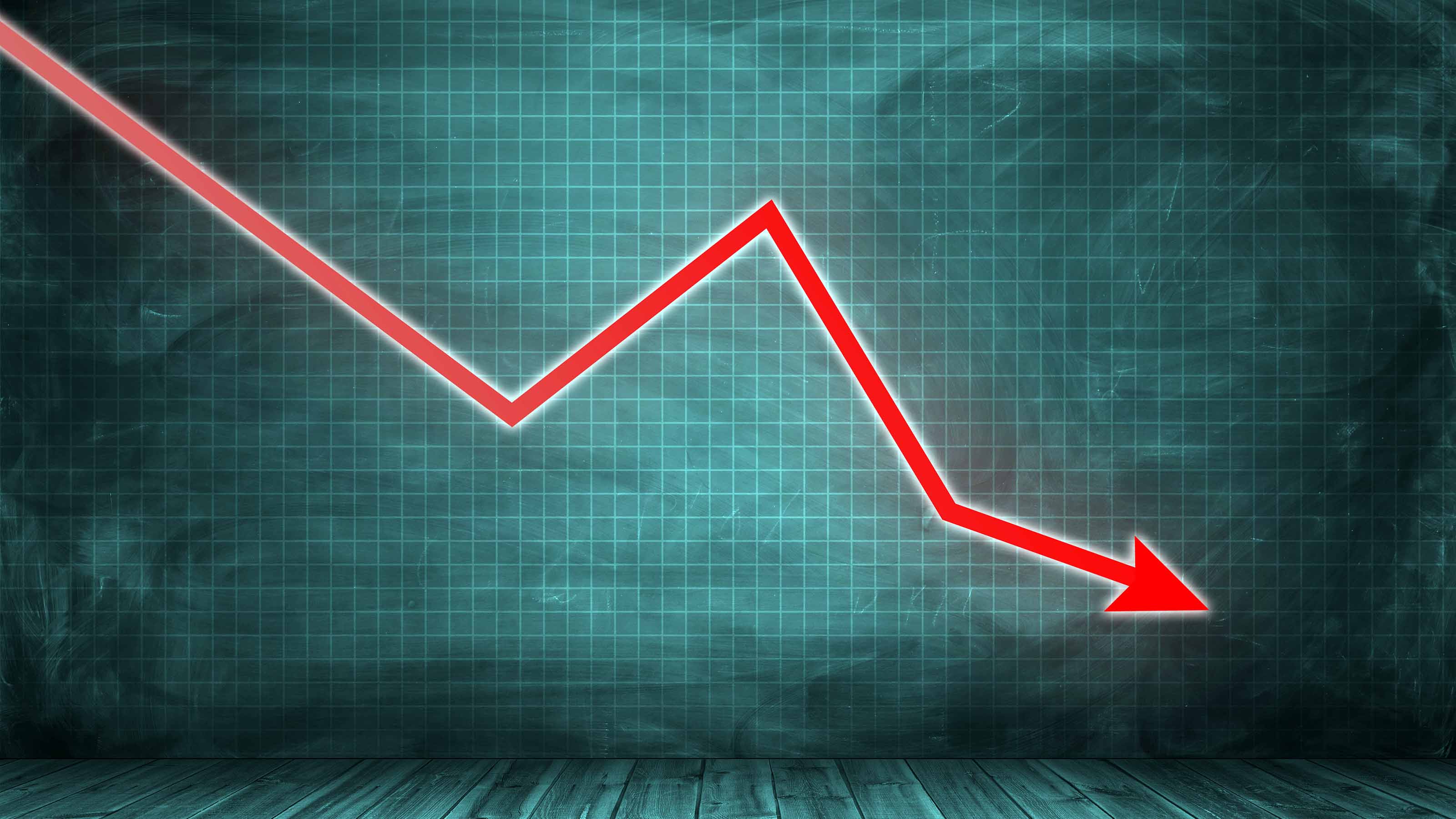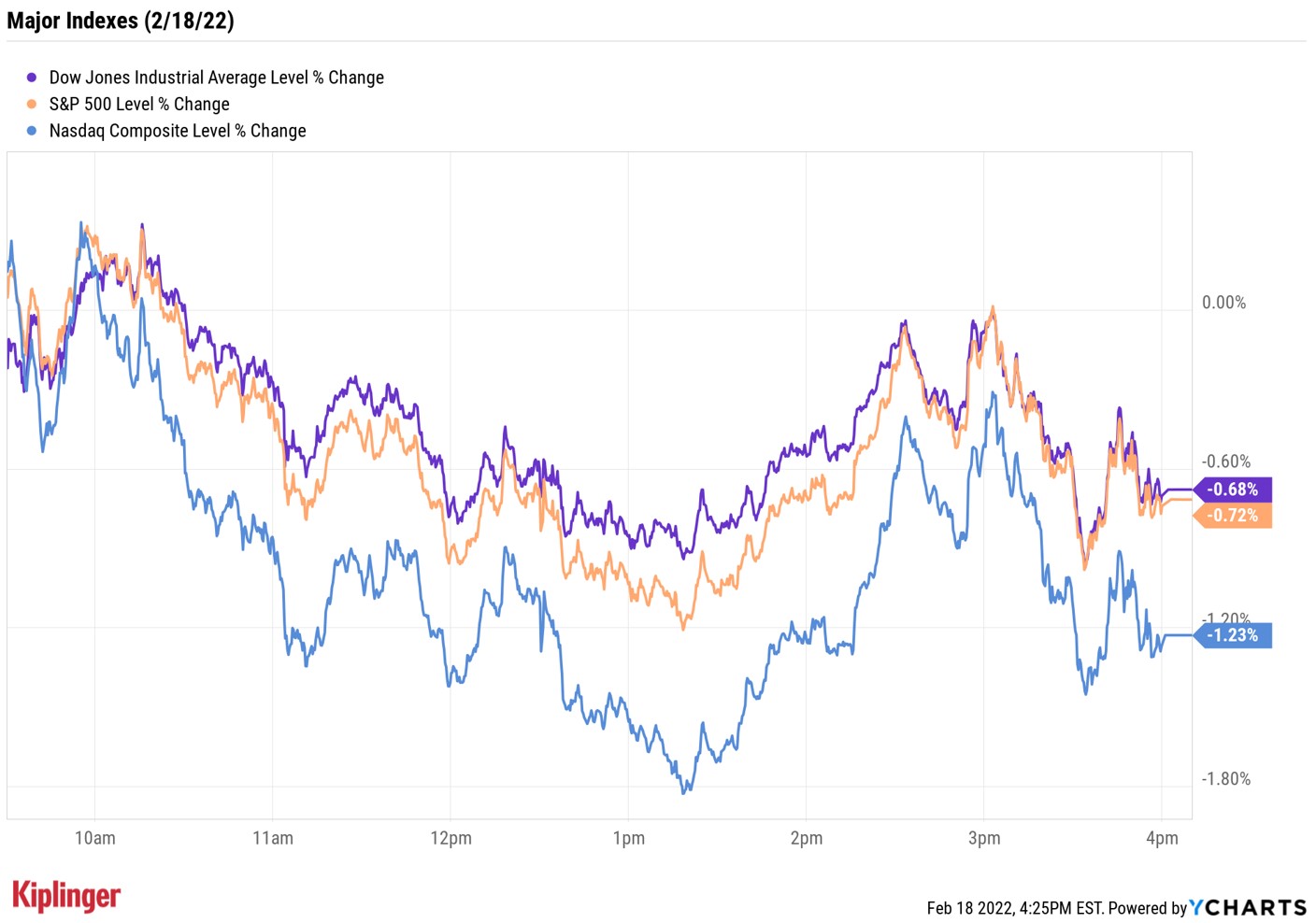Stock Market Today: Stocks Drop on Russia-Ukraine, Fed Uncertainty
Today's batch of Fed presenters failed to give specifics on the central bank's rate-hike plans.


Stocks were dragged lower for a second straight day after several U.S. officials issued warnings that Russia could attack Ukraine in the next several days.
Also, presentations by several members of the Federal Open Market Committee left investors wanting for more detail about the central bank's impending tightening plans.
Among them was New York Fed President John Williams, who, while speaking at a New Jersey City University event, said "it will be appropriate to raise the target rate" in March but didn't specify by how much.

Sign up for Kiplinger’s Free E-Newsletters
Profit and prosper with the best of expert advice on investing, taxes, retirement, personal finance and more - straight to your e-mail.
Profit and prosper with the best of expert advice - straight to your e-mail.
Also in focus today was data from the National Association of Realtors that showed existing-home sales climbed 6.7% month-over-month in January to a seasonally adjusted annual rate of 6.5 million units.
This was the biggest sequential rise since July 2020, says Jennifer Lee, senior economist at BMO. And the gains were broad-based across both categories of homes and regions in the U.S. According to Lee, this is likely indicative of "the rush to get in before borrowing costs move higher. The Fed's communication has been crystal clear on that front … warning that higher rates are just around the corner."
At the close, the Nasdaq Composite was down 1.2%% at 13,548, the S&P 500 Index was off 0.7% at 4,348 and the Dow Jones Industrial Average ended with a 0.7% loss at 34,079 – though all three indexes finished off their session lows.
As a reminder, the U.S. stock market will be closed Monday in observance of Presidents' Day.

Other news in the stock market today:
- The small-cap Russell 2000 gave back 0.9% to end at $2,009.
- U.S. crude futures shed nearly 0.8% to settle at $81.07 per barrel.
- Gold futures slipped 0.1% to $1,899.80 an ounce.
- Bitcoin fell 2.2% to $40,032.78. (Bitcoin trades 24 hours a day; prices reported here are as of 4 p.m.)
- DraftKings (DKNG) plunged 21.6% after the sports betting company reported earnings. In its fourth quarter, DKNG reported a slimmer-than-expected adjusted loss of 35 cents per share on higher-than-anticipated revenue of $473 million. But the firm said it expects a fiscal 2022 adjusted EBITDA (earnings before interest, taxes, depreciation and amortization) loss of $825 million to $925 million, wider than what Wall Street is projecting. "DraftKings is facing intense pressure from newer entrants in the mobile sports betting space from established brands like Caesars and BetMGM," says Jonathan Dube, executive in residence at investment bank Progress Partners. "Investors will be watching new state rollouts aggressively. The recent rollouts in New York and Louisiana have pushed off projected profitability from Q4 2022 to at least Q4 2023, according to the latest guidance, due to intense competition and high marketing costs."
- Roku (ROKU) was another post-earnings loser, shedding 22.3% after the streaming giant's fourth-quarter results. ROKU recorded adjusted earnings of 17 cents per share for the three-month period, higher than the 9 cents per share analysts were anticipating. However, fourth-quarter revenue of $865.3 million fell short of the $894 million expected by Wall Street and the company offered up current-quarter revenue guidance below analysts' consensus forecast. "After its relatively lackluster fourth-quarter results, ROKU sees global supply-chain disruptions and inflationary pressures still weighing on its 2022 active account growth and video monetization in some ad categories," says CFRA Research analyst Tuna Amobi, who maintained a Hold rating on the stock. "Still, we think ROKU remains relatively well-positioned for an accelerated secular shift to streaming from traditional TV, likely to bode well for longer-term audience engagement."
What Corporate America is Really Talking About
While the stock market may be worried about a potential Russian invasion of Ukraine, S&P 500 companies don't seem to be.
"During each corporate earnings season, it is not unusual for companies to comment on subjects that had an impact on their earnings and revenues in a given quarter, or may have an impact on earnings and revenues in future quarters," says John Butters, senior earnings analyst at FactSet.
But in a search of all S&P 500 firms that had earnings conference calls between Dec. 15 and Feb. 17, "Ukraine" was cited in just 4% of those calls. "By contrast, 72% of S&P 500 companies have cited 'inflation' on earnings calls over this same period," Butters adds.
While companies often have options in combating higher inflation, so too do investors. One potential way to guard a portfolio against inflation risk is with defensive, dividend-paying plays such as healthcare stocks or real estate investment trusts (REITs).
Another is to consider consumer staples stocks, which tend to hold up during periods of higher prices. Read on as we look at some of the best consumer staples stocks for 2022, many of which offer investors some level of defense against rising prices.
Get Kiplinger Today newsletter — free
Profit and prosper with the best of Kiplinger's advice on investing, taxes, retirement, personal finance and much more. Delivered daily. Enter your email in the box and click Sign Me Up.

With over a decade of experience writing about the stock market, Karee Venema is the senior investing editor at Kiplinger.com. She joined the publication in April 2021 after 10 years of working as an investing writer and columnist at a local investment research firm. In her previous role, Karee focused primarily on options trading, as well as technical, fundamental and sentiment analysis.
-
 Stock Market Today: Stocks Struggle Amid Tariff Uncertainty
Stock Market Today: Stocks Struggle Amid Tariff UncertaintyBoeing dropped after China suspended new aircraft orders, while Bank of America and Citi climbed on earnings beats.
By Karee Venema
-
 Starbucks 2025 Dress Code Changes: See the New Look
Starbucks 2025 Dress Code Changes: See the New LookThe 2025 Starbucks dress code change features a uniformed look as part of creating a more familiar and friendly cafe experience.
By Sean Jackson
-
 Stock Market Today: Stocks Struggle Amid Tariff Uncertainty
Stock Market Today: Stocks Struggle Amid Tariff UncertaintyBoeing dropped after China suspended new aircraft orders, while Bank of America and Citi climbed on earnings beats.
By Karee Venema
-
 Stock Market Today: Stocks Gain on Tech, Auto Tariff Talk
Stock Market Today: Stocks Gain on Tech, Auto Tariff TalkThe Trump administration said late Friday that it will temporarily halt tariffs on some Chinese tech imports.
By Karee Venema
-
 Stock Market Today: Stocks Surge to Close a Volatile Week
Stock Market Today: Stocks Surge to Close a Volatile WeekIt was another day with a week's worth of both news and price action, but it ended on a strongly positive note.
By David Dittman
-
 Stock Market Today: Uncertainty Proliferates: Dow Loses 1,014 Points
Stock Market Today: Uncertainty Proliferates: Dow Loses 1,014 PointsWeaker-than-expected consumer inflation data wasn't enough to stabilize sentiment during another volatile day for financial markets.
By David Dittman
-
 Stock Market Today: Tariff Pause Triggers 3,000-Point Dow Rally
Stock Market Today: Tariff Pause Triggers 3,000-Point Dow RallyThe bond market is sending concerning signals as the Trump administration executes its rapid reordering of global trade relationships.
By David Dittman
-
 Stock Market Today: Tariff Talks Drive Another Up-and-Down Day
Stock Market Today: Tariff Talks Drive Another Up-and-Down DayTrade war negotiations are happening, but the "fear gauge" is gyrating, and investors, traders and speculators are still searching for signs of a bottom.
By David Dittman
-
 Stock Market Today: Trump Pushes Dow Into 2,600-Point Swing
Stock Market Today: Trump Pushes Dow Into 2,600-Point SwingTariffs and trade war weigh on prices across global financial markets, with little light at the end of the tunnel.
By David Dittman
-
 Stock Market Today: Dow Drops Another 2,231 Points to Hit a Correction
Stock Market Today: Dow Drops Another 2,231 Points to Hit a CorrectionThe Nasdaq Composite, meanwhile, entered a new bear market with its latest slide.
By Karee Venema